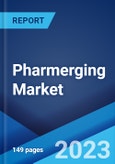The global pharmerging market size reached US$ 1.1 Billion in 2022. Looking forward, the publisher expects the market to reach US$ 2.2 Billion by 2028, exhibiting a growth rate (CAGR) of 12.2% during 2022-2028.
Pharmerging refers to a group of countries that hold low positioning in the pharmaceutical market but have a speedy growth. Some of the key pharmerging markets include China, India, Brazil, Russia, South Africa, Mexico, Indonesia, Turkey, etc.
The increasing healthcare expenditures along with the rising number of private hospitals are currently propelling the global pharmerging market growth. Additionally, the high prevalence of numerous chronic diseases and growing consumer awareness towards early disease detection and treatment procedures are further augmenting the market growth. Moreover, the increasing geriatric population, who are more prone to serious medical conditions, such as dementia, hypertension, cardiac failure, etc., is also bolstering the demand for pharmaceuticals. Additionally, the introduction of government policies and reimbursement schemes across various countries for reducing the cost of treatment for chronic diseases is also propelling the market growth. Moreover, the growing number of insurance companies in the pharmerging countries offering numerous insurance policies to decrease the out-of-the-pocket expenditures is further augmenting the demand of pharmaceuticals in these countries. Apart from this, the rising investments in extensive R&D activities in the fields of biotechnology, immunology, oncology, etc., for the introduction of advanced treatments are also catalyzing the market growth.
Pharmerging refers to a group of countries that hold low positioning in the pharmaceutical market but have a speedy growth. Some of the key pharmerging markets include China, India, Brazil, Russia, South Africa, Mexico, Indonesia, Turkey, etc.
The increasing healthcare expenditures along with the rising number of private hospitals are currently propelling the global pharmerging market growth. Additionally, the high prevalence of numerous chronic diseases and growing consumer awareness towards early disease detection and treatment procedures are further augmenting the market growth. Moreover, the increasing geriatric population, who are more prone to serious medical conditions, such as dementia, hypertension, cardiac failure, etc., is also bolstering the demand for pharmaceuticals. Additionally, the introduction of government policies and reimbursement schemes across various countries for reducing the cost of treatment for chronic diseases is also propelling the market growth. Moreover, the growing number of insurance companies in the pharmerging countries offering numerous insurance policies to decrease the out-of-the-pocket expenditures is further augmenting the demand of pharmaceuticals in these countries. Apart from this, the rising investments in extensive R&D activities in the fields of biotechnology, immunology, oncology, etc., for the introduction of advanced treatments are also catalyzing the market growth.
Key Market Segmentation:
The publisher provides an analysis of the key trends in each sub-segment of the global pharmerging market report, along with forecasts at the global and country level from 2023-2028. Our report has categorized the market based on product, indication and distribution channel.Breakup by Product:
- Pharmaceuticals
- Patented Prescription Drugs
- Generic Prescription Drugs
- OTC Drugs
- Healthcare
- Medical Devices
- Clinical Diagnosis
- Others
Breakup by Indication:
- Lifestyle Diseases
- Cancer and Autoimmune Diseases
- Infectious Diseases
- Others
Breakup by Distribution Channel:
- Hospitals
- Retail Pharmacies
- Online Stores
- Others
Breakup by Country:
- Tier I
- China
- Tier II
- India
- Brazil
- Russia
- South Africa
- Tier III
- Argentina
- Mexico
- Poland
- Ukraine
- Turkey
- Saudi Arabia
- Egypt
- Algeria
- Nigeria
- Thailand
- Indonesia
- Pakistan
- Others
Competitive Landscape:
The competitive landscape of the industry has also been examined with some of the key players being Sanofi S.A., Pfizer Inc., AstraZeneca Plc, GlaxoSmithKline Plc, F. Hoffmann-La Roche AG (Roche AG), Eli Lilly and Company, Johnson & Johnson, Abbott Laboratories, Novartis AG and Teva Pharmaceutical Limited.Key Questions Answered in This Report:
- How has the global pharmerging market performed so far and how will it perform in the coming years?
- What are the key regional markets?
- What is the impact of COVID-19 on the global pharmerging market?
- What is the breakup of the market based on the product?
- What is the breakup of the market based on the indication?
- What is the breakup of the market based on the distribution channel?
- What are the various stages in the value chain of the industry?
- What are the key driving factors and challenges in the market?
- What is the structure of the global pharmerging market and who are the key players?
- What is the degree of competition in the market?
Table of Contents
1 Preface3 Executive Summary11 Value Chain Analysis
2 Scope and Methodology
4 Introduction
5 Global Pharmerging Market
6 Market Breakup by Product
7 Market Breakup by Indication
8 Market Breakup by Distribution Channel
9 Market Breakup by Country
10 SWOT Analysis
12 Porters Five Forces Analysis
13 Competitive Landscape
List of Figures
List of Tables
Companies Mentioned
- Sanofi S.A.
- Pfizer Inc.
- AstraZeneca Plc
- GlaxoSmithKline Plc
- F. Hoffmann-La Roche AG (Roche AG)
- Eli Lilly and Company
- Johnson & Johnson
- Abbott Laboratories
- Novartis AG and Teva Pharmaceutical Limited
Methodology

LOADING...
Table Information
| Report Attribute | Details |
|---|---|
| No. of Pages | 149 |
| Published | November 2023 |
| Forecast Period | 2022 - 2028 |
| Estimated Market Value ( USD | $ 1.1 Billion |
| Forecasted Market Value ( USD | $ 2.2 Billion |
| Compound Annual Growth Rate | 12.2% |
| Regions Covered | Global |
| No. of Companies Mentioned | 9 |









